Chair Frames: Construction, Materials, and Design Principles
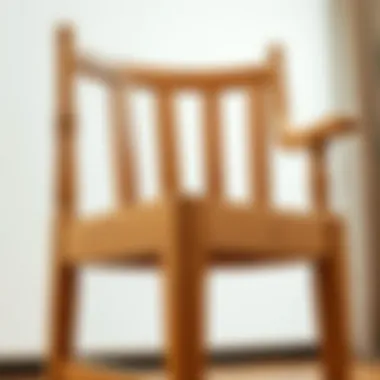
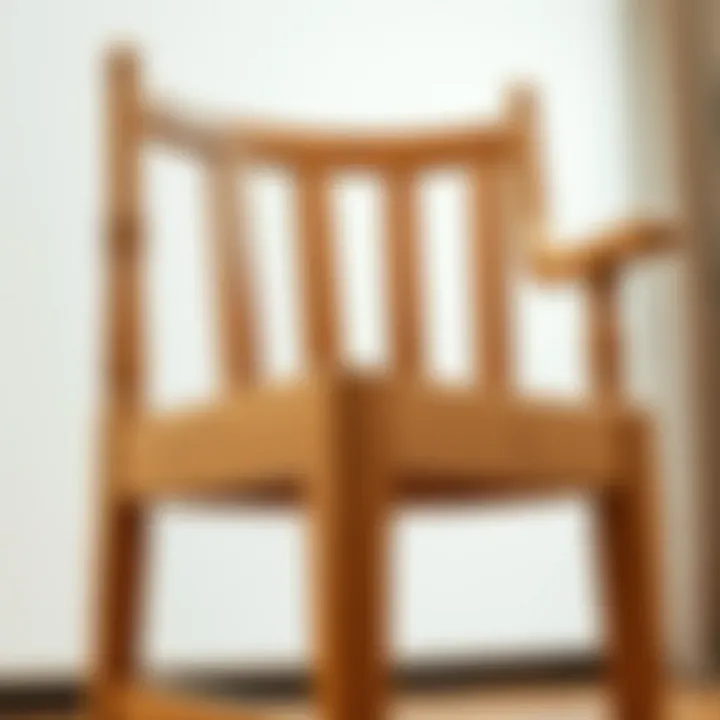
Intro
When it comes to furniture, the chair is an essential component, serving practical purposes while also adding character to a space. However, beneath the surface of what makes a chair appealing lies the often-overlooked but vital aspect of its frame. The chair frame is more than just a supporting structure; it is the backbone that influences durability, comfort, and overall design. In the world of chair frames, understanding the nuances of construction, materials, and design principles can transform how one sees furniture. This article sets out to illuminate those elements, providing homeowners, interior decorators, and DIY enthusiasts with the necessary insights to make informed decisions in their furniture selections.
Often, we admire a chair for its plush cushions or striking color. But a well-formed chair frame is what allows those aesthetic qualities to endure. Whether you are seeking rustic charm, vintage elegance, or contemporary sleekness, knowing the ins and outs of chair frames opens up a new level of appreciation for furniture craftsmanship. This exploration will cover essential topics from current furniture design trends to practical tips for ensuring longevity in your chairs.
Furniture Design Trends
Current Styles and Themes
In recent years, the world of furniture design has witnessed shifts towards more adaptive and sustainable choices. This change influences how chair frames are constructed and finished, offering a wide range of styles that resonate with diverse tastes. Modern minimalist designs often feature sleek, angular frames crafted from metals or engineered woods. These designs celebrate simplicity without sacrificing function.
On the other hand, the warmth of mid-century modern themes persists, showcasing organic materials and rounded silhouettes. The charm of traditional styles, like the classic Windsor chair or Victorian pieces, remains popular as well, incorporating elaborate frames with intricate detailing that reflect craftsmanship of yesteryears.
Color Palettes and Materials
The choice of color and material plays a significant role in chair design, ultimately influencing the mood of a space. Soft pastels and earthy tones are making headway as preferred choices, creating inviting atmospheres. Wood, metal, and upholstery blend smoothly within these palettes, aligning functionality with aesthetics. In recent trends, sustainable materials such as bamboo and reclaimed wood are gaining traction, not only for their durability but also for the environmental benefit they offer.
In the case of upholstery, choices range from luxurious leathers and soft, cozy fabrics to innovative, eco-friendly options. Each material lends a different character to the chair, inviting various tactile experiences while also serving a functional purpose. Choosing the right combination enhances the overall appeal of the furniture and anchors the aesthetics of a room.
"The frame of a chair is like the spine of a body; it needs to be strong yet flexible to support comfort and style."
Practical Furniture Tips
How to Choose the Right Size
Selecting the right size for a chair frame is an often underestimated aspect. A chair that’s too large can overpower a small room, while a chair that’s too small may get lost in a spacious area. Measure the intended space carefully, factoring in the dimensions of the chair frame along with other furniture. As a rule of thumb, allow for ample movement, at least 28 to 30 inches of walkway space around dining chairs, to ensure comfort while seated or when getting up.
Maintenance and Care for Longevity
Like all furniture, chair frames require proper care to ensure they last over time. Here are a few maintenance tips to keep in mind:
- Regular Cleaning: Dust and wipe down chair frames as required, using gentle cleaners for different materials. Avoid excessive moisture, especially for wooden frames.
- Check for Stability: Periodically inspect joints and connections; tightening screws or bolts can help maintain frame integrity.
- Avoid Direct Sunlight: For upholstered and wooden chairs, exposure to direct sunlight can cause fading and weakening of the materials.
By understanding these facets, one can make smarter choices in selecting furniture that not only fits their aesthetic criteria but also withstands the test of time.
The Fundamentals of Chair Frames
Chair frames represent the backbone of any seating arrangement, providing structure, stability, and support that ultimately informs not just functionality, but also aesthetics within a space. As we dive into the world of chair frames, it’s critical to understand their foundational role in furniture design. Without a solid frame, a chair might as well be little more than a collection of cushions on the floor.
Definition and Purpose
To put it plainly, chair frames are the supportive structures upon which the rest of the chair is built. They define the chair's shape, dictate how it will handle weight, and significantly influence comfort. Constructed typically from materials such as wood, metal, or plastic, these frames are engineered to absorb stress and withstand regular use over extended periods.
A well-crafted chair frame serves several key purposes:
- Support: It holds the chair together and provides stability. When someone leans back, shifts their weight, or sits down abruptly, the frame has to ensure the remaining components stay intact.
- Shape and Ergonomics: The design of the frame affects how the chair conforms to the human body. An ergonomically designed chair can prevent discomfort and support posture.
- Aesthetic Appeal: The frame often plays a leading role in the visual aspects of a chair. Whether it’s the sleek lines of a metal frame or the rustic charm of a wooden one, the frame can dictate the overall style of a chair.
"The best chair isn’t just about comfort; it’s about a marriage of design, functionality, and the story it tells about the room it lives in."
Importance of Chair Frames in Furniture Design
Understanding the significance of chair frames goes beyond mere construction details; it involves appreciating their impact on the entirety of furniture design and usage. Consider this:
- Durability: The choice of frame material—be it hardwood, lightweight aluminum, or sturdy plastic—affects the lifespan and resilience of the chair. In environments where furniture sees high traffic, like cafés or waiting rooms, durable frames are non-negotiable.
- Comfort Level: Without the right frame, plush cushions and beautiful fabrics can be rendered ineffective. A robust structure allows for the proper distribution of weight, which correlates directly to how comfortable the seat feels.
- Market Perception: For homeowners and interior decorators, selecting chairs with quality frames can elevate a room's perceived value. A meticulously designed chair draws the eye and tells a story of careful consideration and design expertise.
- Functionality Across Varied Uses: Chairs used in a home environment differ vastly in functional demands from those in commercial spaces. A sturdy design can adapt to multiple settings without compromising usability, making the frame's versatility a valuable asset in furniture design.
In summary, chair frames are not merely structural elements; they are integral parts of the furniture narrative that blend usability with artistry. Whether for designing new pieces or selecting existing ones, recognizing the weight of every detail—from joint connections to material selections—guides you toward making informed choices in furniture design.
Types of Chair Frames
When it comes to chair frames, understanding the different types can significantly influence your furniture choices and overall design. Each frame material offers unique attributes that contribute to the functionality, aesthetics, and durability of the end product. Whether you are a homeowner looking to furnish your space or a designer aiming to create a standout piece, the type of chair frame is essential.
Wooden Chair Frames
Hardwoods versus Softwoods
Hardwoods and softwoods differ not just in their names but in a multitude of characteristics that impact their usage in chair frame construction. Hardwoods, like oak and mahogany, come from deciduous trees. They are usually denser, which contributes significantly to their durability. This density makes them more resistant to wear and tear, an aspect often a priority for quality furniture.
On the other hand, softwoods, such as pine and fir, come from coniferous trees. They tend to be lighter and easier to work with, making them more accessible for DIY enthusiasts or those without advanced carpentry skills. However, they are generally less durable than hardwoods, which could be a consideration if you're looking for longevity in your furniture pieces.
In the context of this article, both hardwoods and softwoods have their distinct advantages. Hardwood frames offer more robustness, while softwood can provide creative opportunities at a lower price point.
Common Wood Types Used in Frame Construction
In chair frame construction, the choice of wood type plays a critical role in defining the final product’s overall character. Common wood types that have gained popularity include oak, maple, and birch. For instance, oak is widely regarded for its strength and beautiful grain patterns, making it a substantial option for both traditional and contemporary designs.
Maple, being a hard yet affordable choice, can create stunning visual effects when stained. Its fine grain allows for smooth finishes. Then, there is birch, which has become quite a favorite for its versatility and workability. It’s almost easy to shape into complex forms without compromising strength.
Using these types of wood in frame construction can lead to visually appealing and functional furniture. However, the disadvantage is that they may require more maintenance compared to some synthetic options, especially when it comes to maintaining their finish over time.
Metal Chair Frames
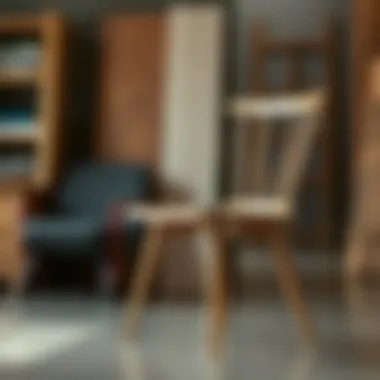
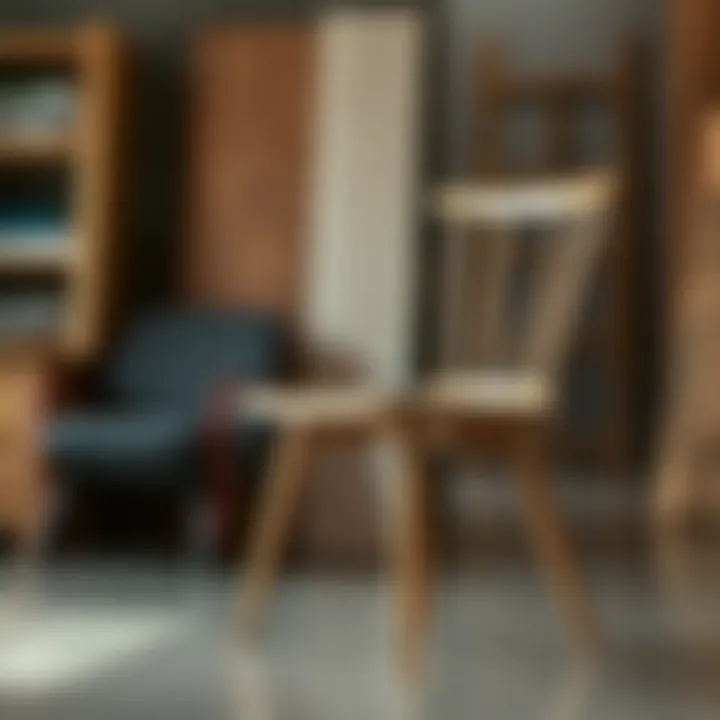
Aluminum
Aluminum frames offer not only a feather-like lightness but also remarkable strength. A highlight of aluminum is its resistance to rust, an essential factor for outdoor furniture. Compared to other materials, aluminum can endure harsh environmental conditions without requiring extensive upkeep.
One unique feature of aluminum is its ability to be molded into elegant shapes, allowing designers to push the boundaries of contemporary aesthetics while retaining function. The downside might include susceptibility to dents and scratches, which may deter some people from choosing aluminum frames for everyday use.
Steel
Steel is another robust option that boasts impressive durability. Known for its strength-to-weight ratio, it can support significant weight without compromising on stability. Steel frames can also be finished in various colors and designs, making them a favorite in modern furniture settings.
However, the higher density of steel means that chairs might become cumbersome to move. An additional consideration is that without proper coating, steel can rust, particularly in humid environments. This trade-off must be considered when selecting materials for chair frames.
Iron
Iron, particularly wrought iron, has a long-standing reputation in furniture design. Its strength rivals that of steel, yet it brings a different aesthetic quality. Often associated with vintage or artisanal designs, iron can add character to an otherwise modern space. The intricate work possible with iron results in unique, decorative chair frames that stand out.
On the flip side, the weight of iron can be a concern for mobility, and it also needs careful maintenance to prevent rust. This balance of beauty and practical challenges highlights the importance of metal chair frames in incorporating both function and style into your home.
Plastic Chair Frames
Types of Plastic Used
The material choices for plastic chair frames are varied, including options like polypropylene and polycarbonate. These plastics are relatively lightweight and flexible, offering a certain level of resilience under pressure, which is advantageous in busy spaces like cafes and event venues.
Polypropylene, known for its durability and UV resistance, is an excellent choice for outdoor seating. Meanwhile, polycarbonate, known for its clarity and strength, can yield visually engaging chairs that can mimic the appearance of glass but at a much lower weight and risk of breakage.
In this article, knowing about plastic options offers readers insight into budget-friendly yet stylish seating solutions. However, the less luxurious feel of plastic compared to wood or metal could be seen as a drawback by high-end users.
Pros and Cons of Plastic Frames
When discussing the pros and cons of plastic chair frames, one of the key characteristics lies within their affordability and ease of maintenance. These chairs are generally resistant to stains and moisture, making them easy to clean and suitable for various environments. Another benefit is that they can often be molded into chic, modern designs, lending an appealing fresh look to any setting.
However, they can feel less sturdy and may lack the warmth that wood or metal frames convey. Additionally, over time, plastic can become discolored from sun exposure. These factors pull the reader to consider carefully how plastic fits into their design philosophy.
In summary, each chair frame type brings its own set of benefits and challenges, demonstrating the importance of choice in furniture design. The decision hinges on how one prioritizes durability, aesthetics, and application within a living space. For customized experiences, homeowners, designers, and retailers owe it to themselves to grasp these fundamental differences and how they shape the character of the furniture.
Chair Frame Construction Techniques
In the realm of furniture design, the chair frame is more than just a support structure; it serves as the backbone of comfort and stability. Understanding the various construction techniques used for chair frames not only enhances their effectiveness but also elevates their aesthetic appeal. Techniques like joinery methods and reinforcement strategies play critical roles in determining how long a chair lasts, how comfortable it is, and even how stylish it looks in a room. By diving deep into these construction techniques, we can appreciate the craftsmanship involved and the decisions that go into creating a piece of furniture that stands the test of time.
Joinery Methods
Joinery is the art of connecting two pieces of material, and when it comes to chair frames, the choice of joint can significantly impact both strength and visual appeal. Let’s explore some common joinery methods used in chair frame construction.
Dovetail
The dovetail joint is renowned for its ability to create a strong, interlocking connection between two pieces of wood. This design resembles a dove’s tail, hence the name. Its key characteristic is the trapezoidal shape of the joint, which resists being pulled apart, making it an excellent choice for chair frames that need to endure weight and movement.
One striking feature of the dovetail joint is its aesthetic quality; it often appears as a decorative element in the finished piece. This joint is particularly favored in high-end furniture since it showcases the craftsperson’s skill. However, crafting dovetail joints can be labor-intensive, making them more costly.
Advantages:
- Exceptional strength and stability.
- Aesthetic appeal enhances visual value.
Disadvantages:
- Requires skilled craftsmanship.
- More time-consuming to produce compared to simpler joints.
Mortise and Tenon
Another classic method is the mortise and tenon joint, where a projecting piece (the tenon) fits snugly into a hole (the mortise). The strength of this joint lies in the surface area contact; more contact surfaces mean more strength, crucial for supporting the structure of a chair.
This method is widely regarded as one of the oldest joinery techniques used in furniture making. It’s not only robust but also allows for some degree of flexibility, which is useful in chairs that may move or flex with use. Its versatility makes it a popular choice for various styles of furniture.
Advantages:
- High strength allows for heavy load-bearing.
- Flexibility in design and applications.
Disadvantages:
- Requires precise cutting to ensure snug fit.
- Can be challenging to align accurately.
Screwing and Gluing
Modern manufacturing often employs screw and glue joinery, which combines mechanical fastening with adhesive elements. The simplicity of this method makes it very popular, especially in mass-produced furniture, where speed and cost-effectiveness are crucial.
The main draw of screwing and gluing lies in its straightforward execution and adaptability in various designs. This method is less labor-intensive than traditional joinery techniques, lending itself well to rapid production. However, the longevity may be compromised over time due to the potential weakening of the glue or loosening of screws.
Advantages:
- Quick and easy assembly process.
- Lower production costs.
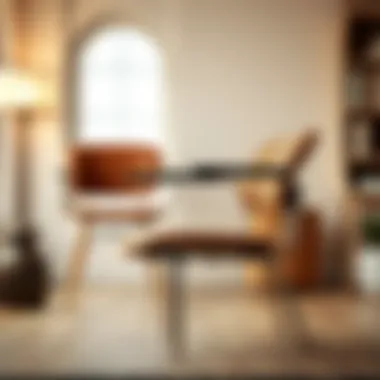

Disadvantages:
- Potential for joints to fail over time.
- Less aesthetic appeal compared to traditional joins.
Methods of Reinforcement
Just as the practice of joinery strengthens the fundamental connections in a chair, reinforcement methods enhance the overall durability and function of the frame. These techniques ensure that the chair can withstand daily use without compromising comfort or stability.
Bracing
Bracing involves adding extra support between frame components, effectively minimizing movement that can lead to structural failure. The most common form is diagonal bracing, which provides additional stability against lateral forces, especially in chairs subjected to leaning or rocking.
The key characteristic of bracing is its ability to distribute load more evenly across the frame. This method is commonly used in dining chairs and rocking chairs to improve safety and comfort. It is a straightforward yet effective solution, often unnoticed yet paramount for stability.
Advantages:
- Reduces risk of wobbling or breaking.
- Elevates overall strength of the chair frame.
Disadvantages:
- Can add to the weight of the chair.
- Requires careful planning to avoid compromising aesthetic.
Cross Support
Cross supports are another reinforcement technique, typically running across the width or length of the chair frame. This design effectively counters bending and sagging, which are common concerns in older, more traditional chair designs.
The unique feature of cross supports is their versatility; they can be added to almost any style of chair frame to enhance strength. This reinforcement can be built into the original design or added later for increased durability.
Advantages:
- Enhances overall structural integrity.
- Can adapt to various design aesthetics.
Disadvantages:
- May affect the visual flow of the chair.
- An additional design consideration may complicate construction.
Materials Used in Chair Frame Construction
The choice of materials is a cornerstone in the world of furniture design, especially when it comes to chair frames. Selecting the right material not only influences the aesthetics but also plays a pivotal role in the durability and comfort of a chair. Each material has its own unique characteristics, strengths, and weaknesses, which influence its appropriateness for various applications. In this section, we dig into the significance of these materials, with a focus on assessing durability, weight, and the broader environmental impact of material choices.
Assessing Durability and Weight
Durability is arguably the most crucial factor when discussing materials for chair frames. It determines how long a chair will endure frequent use without losing its form or comfort. Here are some common materials used in chair frame construction and how they rate for durability:
- Wood: Generally durable, especially hardwoods like oak or maple. They can withstand years of use if well-maintained.
- Metal: Aluminum and steel are well-known for their strength. Steel can be particularly durable but may be heavier, while aluminum offers a lightweight option with good resistance to rust.
- Plastic: Often less durable than wood or metal but can still serve well in light-use situations. Some high-density plastics have improved over the years, providing better durability and resistance to wear.
Weight Considerations
The weight of the chair frame cannot be overlooked. Lighter materials, such as aluminum and certain plastics, make chairs easier to move and more versatile in different environments. However, lighter does not always mean weaker. Some well-engineered metal and composite materials can provide strength and stability without being cumbersome.
"The balance between durability and weight is like walking a tightrope; one misstep can mean a chair that's too heavy to lift or too flimsy to endure."
Environmental Impact of Material Choices
Choosing materials wisely also entails considering their environmental footprint. With the growing consciousness around sustainable design, many customers and designers are evaluating the impact of their material choices. Here are a few aspects to consider:
- Renewability: Wood sourced from sustainably managed forests or reclaimed wood options can provide environmental benefits. However, overharvesting can be detrimental.
- Manufacturing Process: Metals, particularly aluminum, often require significant energy for production, yet they are infinitely recyclable, giving them a sustainable edge.
- Recyclability: Plastic can be a double-edged sword. While some plastics are recyclable, countless pieces end up in landfills. Yet, innovations in biodegradable plastics are on the rise, aiming to reduce waste.
The discussion around materials in chair frames is not merely theoretical. Each choice has real-world implications, affecting not just the physical attributes of the chair, but also its ecological footprint. While durability and weight are fundamental considerations, the environmental consequences of these materials are shaping the future of furniture design as we strive for more sustainable options. Understanding these materials allows homeowners, designers, and decorators to make more informed decisions that align with aesthetic preferences, practical needs, and ethical considerations.
Design Principles Influencing Chair Frames
The design principles that influence chair frames play a pivotal role in determining both the visual appeal and functionality of a chair. As homeowners, interior decorators, and furniture enthusiasts explore furniture choices, understanding this foundational aspect is crucial. It’s not merely about how a chair looks; it’s equally about how it feels and serves its purpose in a home or any space. A well-thought-out design integrates multiple layers of consideration, including aesthetics, functionality, and ergonomics.
Aesthetics and Functionality
Aesthetics encompass the visual aspects of a chair frame, such as its form, color, and material finish. These visual cues must harmoniously blend with the decor of a space, complementing existing furniture while adding its unique touch.
- Material Selection: Different materials bring varied aesthetics. For instance, a wooden frame can evoke warmth and tradition, while metal frames often lend a more industrial and sleek appearance.
- Shape and Form: The lines of the chair—curved, angular, or a combination—can contribute to its overall aesthetic. Rounded edges may invite comfort, while sharp lines often signify modernity.
- Color Schemes: Color can be a significant factor in attracting attention or maintaining subtlety in a room. A bright yellow chair might serve as a focal point, whereas muted tones can blend seamlessly into the background.
However, aesthetics must not overshadow functionality. A chair that looks exquisite but fails to serve its intended purpose ends up as just another decor item collecting dust. Key functional considerations include:
- Stability: The chair needs to be built rigid enough to support a variety of weights without compromising safety.
- Durability: Quality materials ensure longevity, resisting wear and tear over time.
- Adaptability: Many modern designs allow for adjustment. For example, dining chairs should be easy to tuck under a table, while lounge chairs often feature reclining abilities for comfort.
The interplay between aesthetics and functionality can yield sophisticated designs that sculpt a unique ambiance while meeting everyday needs. A chair that embodies this balance is not merely a piece of furniture; it’s a statement of style and practicality.
Ergonomic Considerations
As we delve into ergonomic considerations, it becomes evident that the design of chair frames goes beyond beauty to encompass the health and comfort of the user. Ergonomics concerns how people interact with their environment, and when applied to chair design, it can significantly impact user well-being. Here are some key points:
- Posture Support: Proper chair design must assist users in maintaining a healthy posture to avoid strain on the back, neck, and shoulders. A well-angled backrest provides support, while seat depth accommodates various body types.
- Seat Height and Width: Adjusting seat height to fit average table heights is essential. When chair frames are designed with adjustable heights, they cater to a broader range of users, enhancing usability in shared spaces.
- Cushioning and Padding: Though it might be tempting to skimp on this aspect, adequate padding in seat and back areas can drastically enhance comfort, allowing users to sit for extended periods without discomfort.
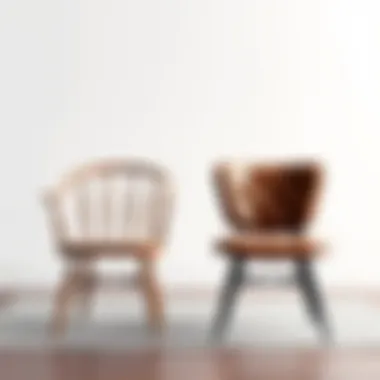
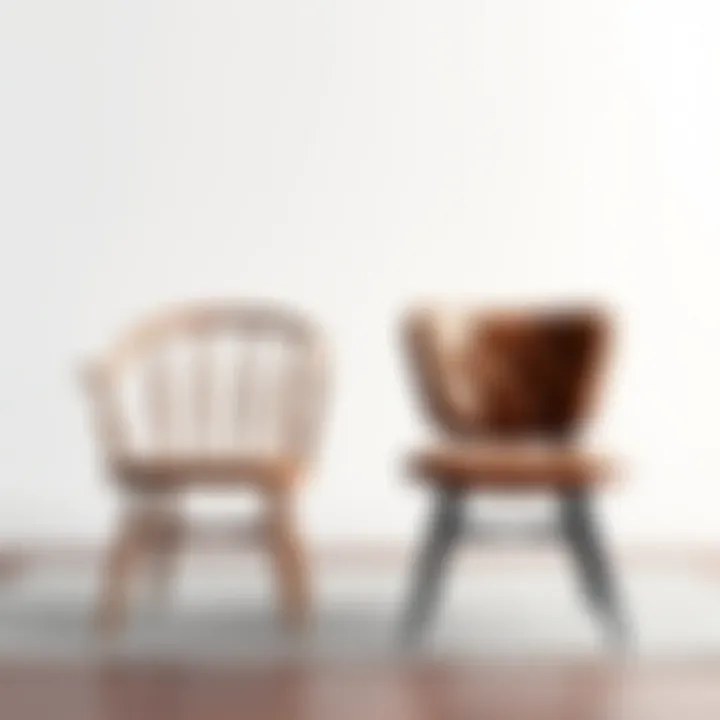
Ergonomics not only improve comfort but can also influence productivity and overall mood. By ensuring that chair frames prioritize user comfort alongside visual appeal, designers and manufacturers contribute positively to the daily experience of individuals utilizing the furniture.
"Good design isn't just what we observe; it’s about how we feel when we use it. The chair must resonate comfort and support without shouting for attention."
When these principles of design are in harmony, the resulting chair frames will not only enhance any space but also promote well-being and productivity, which ultimately enriches the lives of those who use them.
Trends in Chair Frame Design
Understanding the latest trends in chair frame design is crucial for anyone involved in furniture creation or selection. It reflects not just what’s fashionable but also encapsulates evolving consumer preferences towards functionality and sustainability. Knowing these trends can help guide homeowners, interior decorators, designers, furniture retailers, and DIY enthusiasts in making informed choices that align with contemporary aesthetics and practical needs.
In today’s market, consumers lean towards furniture that is not only stylish but also versatile and responsible. Therefore, let's delve into two significant trends shaping the landscape: modern minimalist frames and sustainable designs.
Modern Minimalist Frames
Modern minimalist frames focus primarily on simplicity and efficiency. They tend to feature clean lines, geometric shapes, and a restrained color palette, which align perfectly with contemporary interior design. Such designs avoid the clutter often seen in more ornate furniture, allowing for a calm, uncluttered space that feels more open and inviting.
- Key Characteristics:
- Sleek Profiles: Minimalist frames often boast a sleek and slim silhouette, making them space-efficient.
- Limited Ornamentation: Many modern pieces strip away embellishments, showcasing the material’s natural beauty instead.
- Functional Form: The functionality often drives the design, meaning that each aspect of the chair serves a practical purpose.
One notable example in this realm is the Hans Wegner’s Wishbone chair, which perfectly blends aesthetic appeal and comfort without unnecessary complexity. Homeowners seeking to adopt a minimalist design approach would do well to consider how these frames can enhance their living spaces—helping to create serene environments that support relaxation and focus.
Sustainable Designs
As consumers become increasingly aware of their environmental footprint, sustainable chair frame designs are gaining traction. This trend is not merely about using recycled materials but about considering the entire lifecycle of the product. It incorporates aspects like ethical sourcing, waste minimization, and responsible manufacturing practices.
- Sustainable Materials:
- Reclaimed Wood: Using reclaimed wood in frame construction reduces waste and preserves the planet’s resources.
- Bamboo: A fast-growing, renewable resource, bamboo’s durability makes it ideal for sustainable furniture.
- Bioplastics: Emerging technologies are making it feasible to use bioplastics made from renewable biomass instead of petroleum.
Incorporating sustainable designs not only reduces environmental impact but also appeals to a growing demographic that prioritizes ethical consumerism.
“Choosing sustainable furniture isn't just about the product; it's a mindset that reflects respect for our planet.”
By embracing these trends, homeowners and designers can contribute to a broader movement towards mindful living, while ensuring that their spaces remain relevant, functional, and stylish. As chair frames continue to evolve, staying abreast of these trends will be vital for anyone looking to make impactful furnishings choices.
Chair Frame Maintenance and Care
Taking care of chair frames is essential for ensuring their longevity and functionality. Chairs often endure significant wear and tear, and neglecting their maintenance can lead to more severe issues down the line. By regularly assessing and maintaining these frames, homeowners, designers, and retailers can keep their furniture looking good and performing well for years.
Good maintenance practices not only preserve the aesthetic appeal of your furniture but also enhance safety for users. A broken chair can lead to accidents, and regular checks can prevent such scenarios. Moreover, well-maintained chairs require less frequent repairs, saving time and money. Let's delve into two critical aspects: routine care practices and repair techniques for damage.
Routine Care Practices
Establishing a routine for the care of chair frames is vital. This can make a world of difference in preserving their condition. Here are several useful practices to incorporate into your maintenance schedule:
- Dust Regularly: Keeping chair frames free from dust prevents dirt build-up. Use a soft cloth or dusting tool, especially on wooden frames, to avoid scratches.
- Check for Loose Screws: Periodically inspect your chairs for any loose screws or joints. Tightening these can prevent wobbling and enhance the overall stability of the chair.
- Clean with Appropriate Solutions: Use cleaning agents that match the material of the chair frame. For wooden frames, a mix of mild soap and water can be effective, while metal frames might do well with a suitable metal cleaner.
- Avoid Harsh Chemicals: When maintaining chair frames, refrain from using strong chemicals that could damage the finish. Always test cleaners on a hidden area first.
- Condition Wood Frames: For wooden chairs, consider using oils or waxes specifically made for wood. This helps keep them hydrated and prevents cracking or splitting.
Incorporating these preventive measures allows any potential problems to be addressed before they escalate.
Repair Techniques for Damage
Even with diligent care, damage may still occur. Whether it’s a scratch, a crack in wood, or a dent in metal, knowing how to repair these issues can extend the life of your chairs. Here are some repair methods to consider:
- Fixing Scratches: For wooden frames, small scratches can often be filled with furniture markers or a matching wood putty. Smooth out the area and restain if necessary. For metal, touch-up paint can be used to cover scratches.
- Loose Joints: If a chair frame exhibits loose joints, re-gluing with appropriate wood glue or tightening screws can often do the trick. If the joint appears worn, sometimes adding a wooden dowel for support can provide extra strength.
- Replacing Components: If a part of the chair frame is broken beyond repair, consider replacing it entirely. Seek out replacement parts from furniture stores or specialized retailers to ensure a perfect match.
- Cushion Repairs: If the cushions on your chair are also affected, reupholstering may be required. Use strong upholstery fabric and ensure it is securely stitched to withstand regular use.
Ultimately, being proactive about maintenance and repair can dramatically improve the lifespan of chair frames, saving you time and investment in the long run.
"A stitch in time saves nine." This saying rings true for chair care, as timely actions can prevent extensive damage and costly repairs.
Ending: The Role of Chair Frames in Quality Furniture
When it comes to furniture, one might think of aesthetics first, but the backbone of any chair, both literally and figuratively, is its frame. This concluding section sheds light on how chair frames are integral not just to the chair’s functionality but to the overall quality of furniture in our homes or offices. A robust frame offers the ultimate mix of durability, style, and comfort, making it a critical component in furniture design.
A well-built chair frame directly influences users’ experiences. Think about it: a sturdy frame supports the weight of both the chair itself and the person seated in it. If the frame fails, so does the chair, leading to discomfort or potential injury. Thus, understanding the intricacies of chair frame construction is important, not only for buyers but for manufacturers as well.
Moreover, the choice of materials—wood, metal, or plastic—affects not just the lifespan but also the visual appeal of the chair. Different materials offer varying benefits. For instance, wooden frames might bring a touch of warmth and elegance, while metal frames can project a more modern appearance. In a world increasingly focused on sustainability, material selection also carries ethical implications, making awareness of these choices essential.
The design principles that influence chair frames are equally vital. Aesthetically pleasing frames can enhance the overall look of a space, while a good ergonomic design supports comfort during prolonged use. Without considering these aspects, one might accumulate furniture that fails to meet expectations.
In summary, chair frames are not merely structural supports; they define the quality and usability of the seating they create.
Summary of Key Points
- Structural Integrity: A solid frame provides essential support, contributing to safety and usability.
- Material Choice: The selection of wood, metal, or plastic can affect the longevity and aesthetics of furniture.
- Design Alignment: A harmonious relationship between form and function enhances not just appearance but user comfort.
Future Considerations in Chair Frame Design
As we look to the future, there are several trends and considerations in chair frame design that are noteworthy:
- Sustainability: With the rising awareness of environmental issues, using eco-friendly materials will likely increase. Designers may place greater emphasis on sourcing renewable resources and employing techniques that minimize waste.
- Adaptability: Designs that allow for flexibility—like adjustable seating or multi-functional frames—might become increasingly popular, catering to the evolving needs of consumers.
- Technological Integration: Future chair frames may incorporate smart features. Imagine a chair that can monitor posture or adjust its support based on the user's habits.
- Customization: As personalization becomes a key trend in home furnishings, providing options for frame styles and materials allows the consumer to craft an individual experience tailored to their space.
Indeed, the future of chair frames is poised to blend creativity with functionality in ways we have yet to fully explore.
"The frame is the silent hero of every chair, holding together not just materials but ideas and emotions around gatherings, solitude, and comfort."
For further reading on furniture design principles and materials, you might find these sites informative:
- Wikipedia on Furniture Design
- Britannica on History of Chairs
- U.S. Environmental Protection Agency on Sustainable Practices



